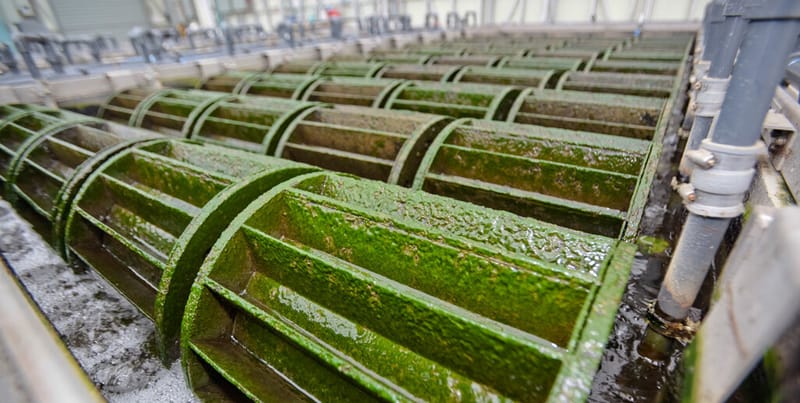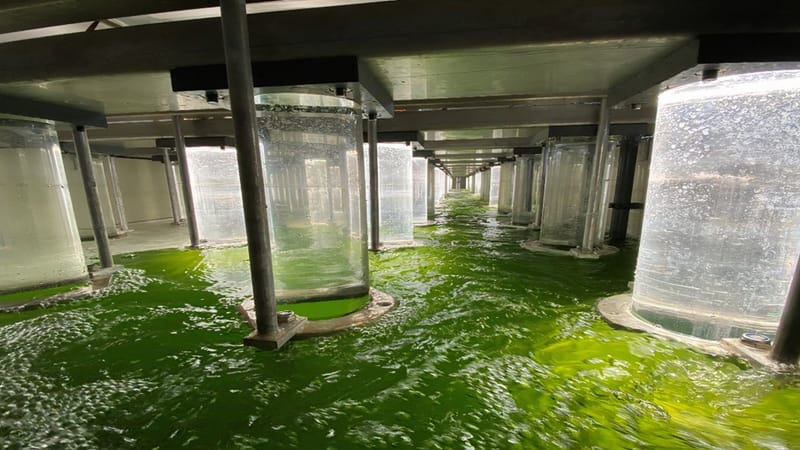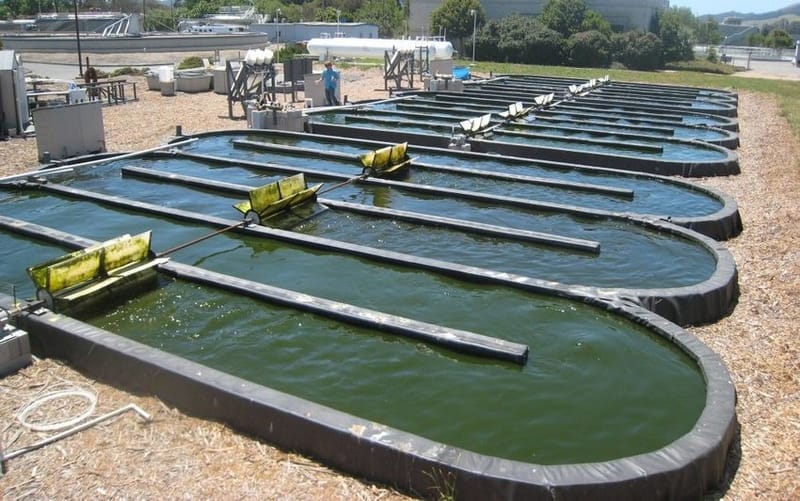Harnessing Algae to Treat Wastewater: A Sustainable Approach
Algae have become a key innovation in the quest for sustainable wastewater treatment, providing environmentally friendly solutions that drastically lower operating costs and environmental effect. Although they are good at controlling pollutants, traditional wastewater treatment techniques can generate environmentally hazardous byproducts and have high energy requirements. As organic biofilters, algae provide a fresh and exciting approach to addressing these issues by facilitating the absorption of nutrients and contaminants while producing biomass that may be utilized for a range of industrial uses. The transformational potential of algae-based technologies to revolutionise wastewater treatment procedures is explored in this blog.

The Role of Algae in Nutrient Removal
One of the main benefits of using algae for wastewater treatment is that they are very good at absorbing excess nutrients like phosphorus and nitrogen. When these nutrients are not effectively managed, they pose serious dangers to the environment's health. They are frequently found in household wastewater, industrial effluents, and agricultural runoff. These nutrients contribute to eutrophication, a process that causes an abundance of algal blooms, when they are released untreated into water bodies. These blooms cause aquatic ecosystems' oxygen levels to drop, resulting in dead zones where marine life cannot live and, eventually, the extinction of the region's biodiversity.
Algae naturally flourish in environments rich in nitrogen and phosphorus, incorporating these nutrients into their biomass as they grow. By integrating algae into wastewater treatment systems, the process not only eliminates these harmful nutrients but also diminishes the need for additional chemical treatments, which can have negative downstream effects on ecosystems. The algae cultivated in these systems can be harvested and utilized for various applications, such as fertilizers or animal feed, thus minimizing waste and fostering a circular economy.

Several types of algae have demonstrated remarkable effectiveness in nutrient removal. Microalgae species like *Chlorella* and *Spirulina* are particularly noteworthy due to their high efficiency in absorbing pollutants and their rapid growth rates under controlled conditions. Research and large-scale pilot projects have shown that algae can achieve up to 90% removal of nitrogen and phosphorus from wastewater. This level of efficiency makes algae-based systems some of the most effective biofilters available today.
The incorporation of algae into wastewater treatment represents a significant advancement in environmental technology. These systems not only offer a sustainable method for managing nutrient pollution but also provide additional benefits by repurposing algae biomass, contributing to waste reduction, and supporting a more sustainable industrial ecosystem. As research and technology in this field continue to evolve, algae-based wastewater treatment has the potential to become a cornerstone of future environmental management strategies.
Energy Efficiency and Carbon Sequestration
One of the significant downsides of conventional wastewater treatment plants is their high energy consumption. Processes such as activated sludge treatment require large amounts of energy, particularly for aeration. Algae-based systems, on the other hand, rely on photosynthesis, harnessing the power of sunlight to fuel their growth. This drastically reduces the energy input required, making algae a low-cost, low-energy alternative to traditional methods.
The photosynthetic process offers another valuable benefit—carbon sequestration. Algae absorb carbon dioxide as part of their natural growth cycle, reducing the overall carbon footprint of the wastewater treatment process. This makes algae-based systems highly attractive for industries and municipalities looking to lower their greenhouse gas emissions. Some treatment plants have even integrated algae with other carbon capture technologies, amplifying their potential to mitigate climate change impacts.
Algae-based systems also produce oxygen during photosynthesis, which can aid in the secondary treatment processes by naturally aerating the wastewater. This not only improves the overall efficiency of the system but also further reduces energy requirements. In addition to nutrient removal, the ability of algae to sequester carbon and reduce energy usage positions them as a highly sustainable solution for modern wastewater treatment challenges.

Challenges and Opportunities for Scaling Up Algae-Based Wastewater Treatment
While algae-based wastewater treatment systems offer innovative and sustainable solutions, they are not without their challenges, particularly when it comes to scaling from laboratory or pilot projects to full-scale industrial applications. Addressing these challenges is crucial for realizing the full potential of algae in wastewater management.
Climate Dependence
One of the primary challenges associated with algae-based systems is their dependence on climate conditions. Algae are highly efficient in warm, sunny environments where they can maximize their photosynthetic activity. This makes them particularly well-suited for regions with consistent sunlight and favorable temperatures. However, in colder or cloudier climates, the efficiency of algae-based systems can significantly diminish. To mitigate this issue, researchers and engineers are exploring several strategies, including the development of closed-loop systems that can provide controlled environments for algae growth. Additionally, the use of artificial lighting and temperature control technologies are being investigated to extend the applicability of algae-based systems to a broader range of geographic locations.
Reliance on the Climate
One of the primary issues with algae-based systems is their dependence on weather patterns. Algae are very efficient when they are in warm, bright circumstances and may maximize their photosynthetic capabilities. They are therefore particularly well adapted to locations with consistent sunlight and pleasant temperatures. However, in colder or cloudier climates, the efficiency of algae-based systems might be significantly decreased. In order to solve this issue, scientists and engineers are looking into a variety of strategies, such as developing closed-loop systems that can provide controlled environments for the growth of algae. Additionally, studies are being done to investigate how temperature control and artificial lighting systems could broaden the geographic use of algae-based systems.
Sustaining Ideal Conditions
Maintaining ideal circumstances for algal development is another major difficulty. For algae to flourish and function well in wastewater treatment, they need a variety of environmental conditions, including light exposure, temperature, and the availability of nutrients. Changes in these parameters may have an effect on the system's efficiency and raise operating expenses. Sufficient control over these factors demands ongoing observation and adaptation in order to preserve the optimal conditions for the development of algae. The operation of algae-based treatment systems is made more difficult and expensive by this necessity, particularly when scaling up to industrial levels.
Addressing Contaminants
Although algae are good at collecting nutrients like phosphorus and nitrogen, they might not be able to remove other kinds of pollution, heavy metals, or medications. These pollutants may be dangerous and persistent, necessitating further treatment procedures to guarantee thorough wastewater purification. It could be essential to combine algae-based systems with other treatment methods or technologies in order to successfully handle these pollutants. Achieving the appropriate degree of water quality requires this integration, which can complicate system design and raise overall costs.

Technical and Economic Viability
Another important factor to take into account is whether scaling up algae-based systems is technically and economically feasible. Large-scale system establishment can need a significant upfront cost, and the payback period might take some time. Widespread acceptance may also be hampered by the technological know-how needed to create, run, and maintain these systems. In order to overcome these obstacles, more research and development is needed to raise the effectiveness and affordability of algae-based treatment methods.
Possibilities for Promotion
There are plenty of chances to advance algae-based wastewater treatment systems in spite of these obstacles. Prospective ways to get beyond current constraints include technological advancements like more energy-efficient lighting and climate control systems, as well as system design innovations like hybrid systems that combine algae with other treatment techniques. A favorable environment for investment and development in this industry is also provided by the growing interest in eco-friendly and sustainable solutions.
In summary
Conversely, the marketability of systems based on algae presents stimulating prospects for creativity. There are already hybrid systems under development that mix algae with other cutting-edge treatment technologies, like as membrane bioreactors. With the addition of further filtration and disinfection processes, these systems seek to capitalize on the inherent advantages of algae while providing a more thorough response to intricate wastewater problems.